St. Anne school celebrates its long Catholic tradition
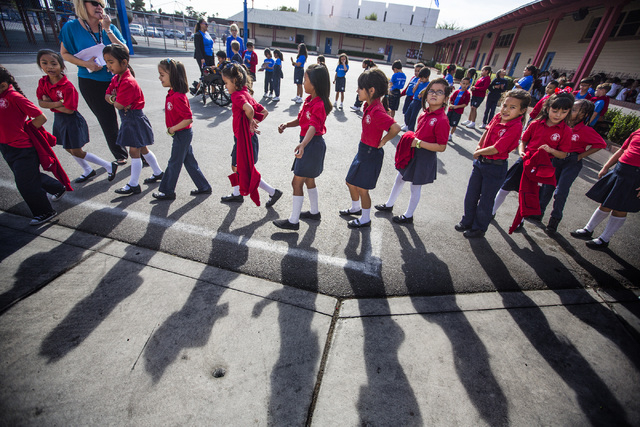
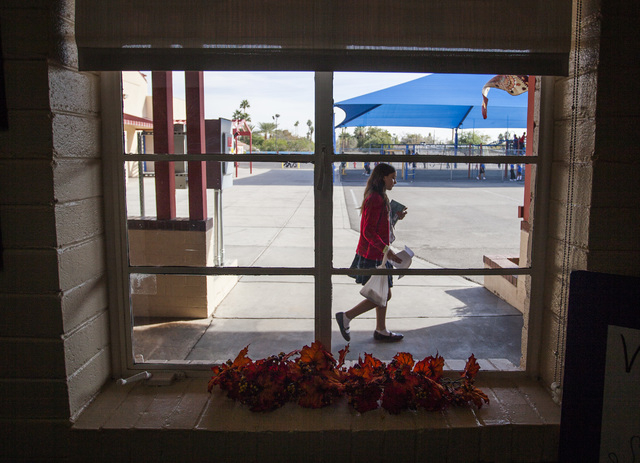
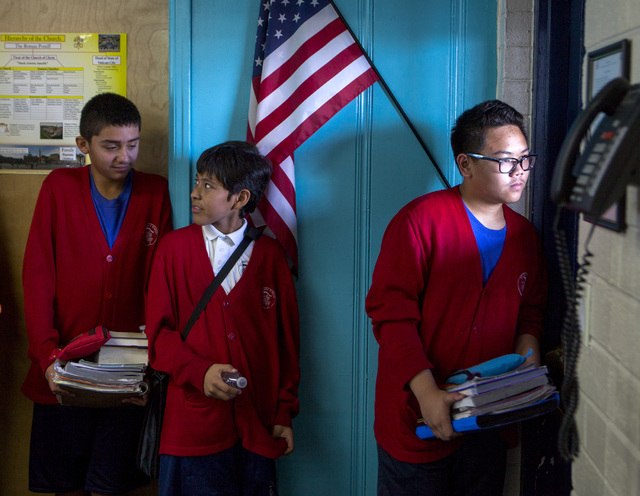
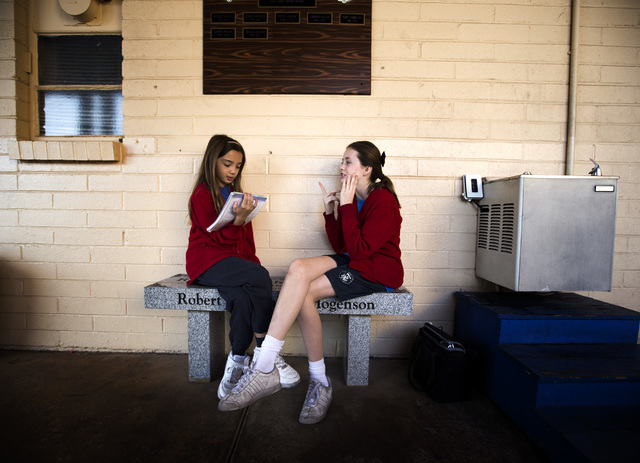
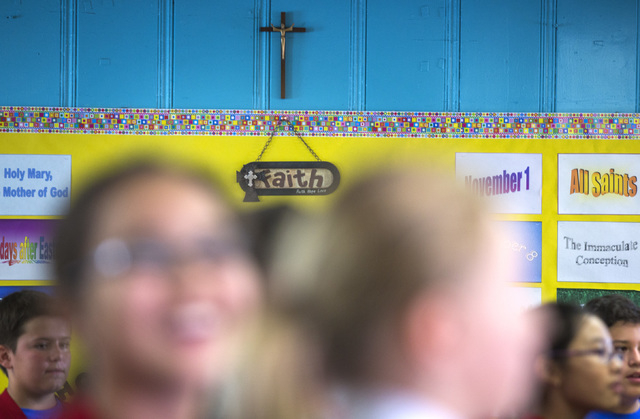
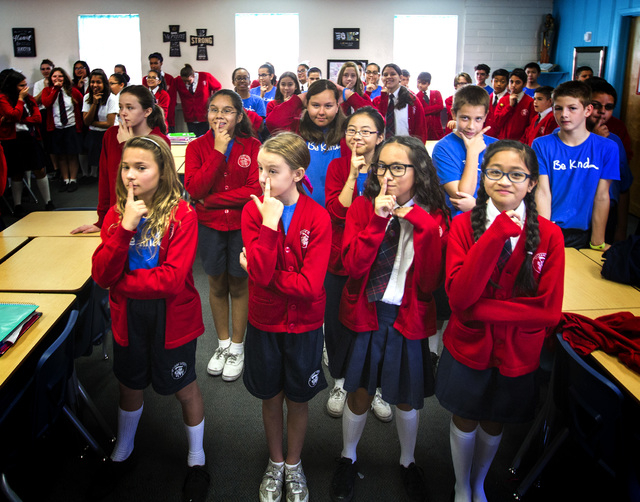
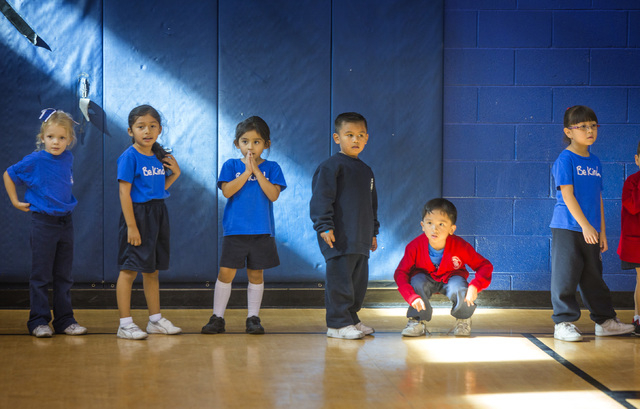
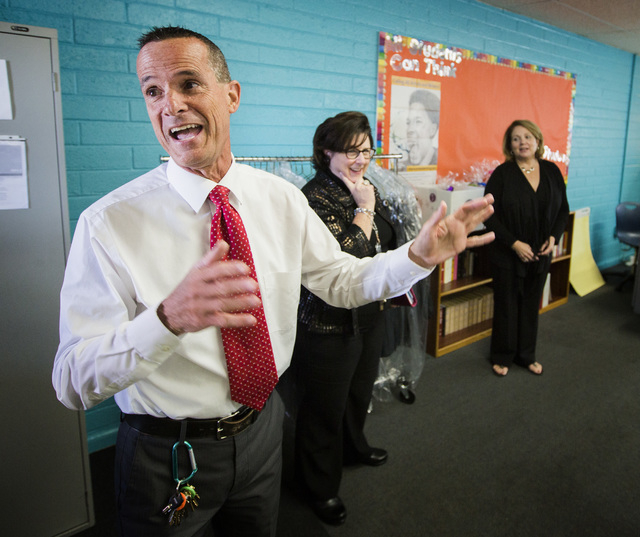
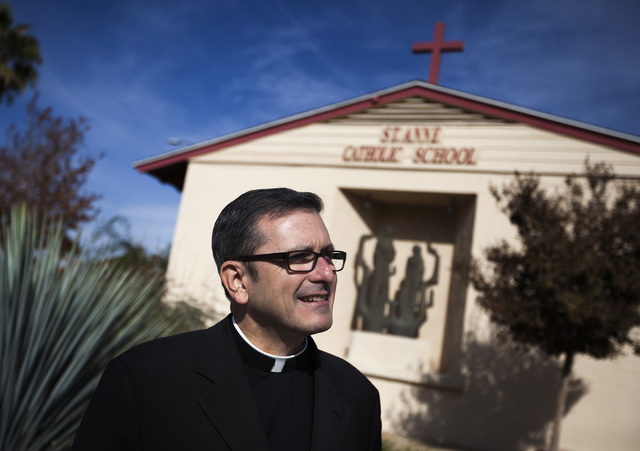
There are signs all over the St. Anne Catholic School campus that hint at the ways it differs from most other schools in town.
Some signs are obvious. The Bible verses emblazoned on exterior walls. The uniforms students wear. The religious statuary outside and the photos of the pope and Catholic clergy on the office walls.
Other signs are subtler, including the way students suddenly — and, to a visitor, even startlingly — rise in unison and offer a good-morning greeting to Principal Thomas Ruggles when he enters a classroom.
It’s enough to give a parochial school alum flashbacks of days gone by. But all of it — the
etiquette, the discipline, even the smiles on kids’ faces — is part of a tradition that continues to serve St. Anne Catholic School well as it celebrates its 60th anniversary.
The legacy of the school, located at 1813 S. Maryland Parkway, will be celebrated by staff, students, teachers and alumni throughout the school year. But St. Anne’s true legacy may lie in the simple reality that, 60 years after its founding, it has not just survived, but is thriving.
Enrollment today is near capacity, notes Monsignor Gregory Gordon, pastor of St. Anne Catholic Church. Although the school still operates out of its original building, the structure has been gussied up and kept up well over the years. And while the curriculum still is based on a foundation of traditional religious education, students today also benefit from such technological advances as campuswide Wi-Fi and electronic tablets.
St. Anne Catholic School opened in the fall of 1954 as, at the time, the second Catholic grade school in Las Vegas. Overseeing the school’s initial four grades were two Sisters of the Holy Cross from Notre Dame, Ind., and two lay teachers. A school history notes that there were 184 students enrolled that first year.
By 1958, the school was hosting first- through eighth-grade classes. In the years since its opening, expansions both structural (including the expansion of a library in 1988 and the opening in 1997 of the Fadwa Ghanem Center, a gym and multipurpose center) and academic (including all-day kindergarten and an after-school program, both begun in 1988) continued.
Today, by virtue of the closing of other local parochial elementary schools in the years since St. Anne’s opened, the school is, Gordon says, “the oldest parochial school in Las Vegas.”
“I was a baby when St. Anne was first built,” recalls Helen Foley, a St. Anne alumna and former chairwoman of the school’s advisory board. “There were several Catholic families that built their homes right on 15th Street. We were one of them — in anticipation of the building of Bishop Gorman (high school) — and they were very recognizable names in the community.”
Foley attended St. Anne during the ’60s, as did her siblings at one point or another, and she notes that St. Anne was a true neighborhood school back then.
“As kids, we were able to walk to school,” she says. “(Students) were able to come home and hang around with their friends after school. It was a really wonderful sense of community.”
St. Anne’s enrollment over the decades rose and fell with the valley’s, and the neighborhood’s, changing demographics. Like most parochial schools of the time, St. Anne in its early years functioned mostly as a school that served parishioners of St. Anne church.
Even today, “parishes have boundaries, and so the main ministry of St. Anne is this territory,” Gordon says. “But the Las Vegas diocese — or, in the (former) Reno-Las Vegas diocese — never had the tradition of a Catholic school in every parish.”
So, St. Anne school always has, to some degree, served children who lived elsewhere in the valley. Today, however, Gordon says the school’s enrollment includes children from “just about every ZIP code in the valley,” in a trend compounded by the closure of all but a handful of other parochial elementary schools here.
“We have a cap of 35 students per grade, so when we have 350, we’re a full school, and we’re at about 340,” Gordon adds. “We have some selected openings in pre-K through third, but we’re filled from fourth grade through eighth grade.”
Ruggles, who has been at St. Anne’s for eight years and has been its principal for three years, recalls that enrollment was at about 280 when he arrived, and Gordon says enrollment has “been steady” in recent years.
What’s behind the school’s healthy enrollment? For one thing, Gordon says, more parents today are “hungry for a values-centered education” for their children.
Each school day at St. Anne begins with students gathering for morning prayers and the Pledge of Allegiance, and each school day ends with another gathering for afternoon prayers. Every Friday morning, students also attend Mass together.
Values aren’t taught in religion class alone, Ruggles adds, but throughout the day.
“I can’t speak for all parents,” Ruggles says, but many parents desire “a curriculum centered on our Catholic faith and, then, learning of the value of being nice adults. And, second, it would be that our curriculum prepares kids to compete in high school and then go to college and, eventually, into the work world.”
St. Anne offers not just values but also, Ruggles says, “the best value” among the valley’s private schools, with single-student tuition of $3,960 for parishioners and $5,280 for nonparishioners.
“We do try to keep our tuition rates low so everybody has a chance for a Catholic education,” he says.
The first thing a visitor to the campus quickly notices — beyond the energetic kids enjoying recess on a recent morning — is how well-maintained the six-decades-old buildings and school property are. That, Gordon says, is owed partly to the slate of carnivals and other fundraisers held at the school that not only raise money to maintain the school but serve as community-building activities.
Also key, Gordon says, is financial assistance from donors, many of whom are alums and many of whom have recognizable Nevada surnames.
“I’m not naming names,” Ruggles says, “but we do have alumni who are movers and shakers.”
Many valley families also can claim a multigenerational presence at the school, he adds, as alumni send their kids to St. Anne’s and their kids, in turn, send their own kids there, too.
Foley, for instance, now has a sixth-grader and a seventh-grader attending St. Anne’s, “so now I’m going through the whole St. Anne’s experiences,” she says with a laugh.
“Almost all of our graduates go to college,” Ruggles says, and many choose, after graduating from eighth grade at St. Anne’s, to attend Bishop Gorman, the valley’s only Catholic high school.
For decades, also beginning in 1954, Bishop Gorman was next door to St. Anne, and St. Anne served as almost a sister school to Gorman. Gordon says the two schools even would share facilities, with high schoolers using St. Anne’s gym and St. Anne students using Gorman’s field. That relationship ended when Gorman moved to Summerlin in 2007, a move that represented a key moment for St. Anne’s.
Foley explains that many families had children attending both Gorman and St. Anne, and liked the convenience of dropping off both kids at what was, essentially, a connected campus. When Gorman moved, parents had to drive to both Summerlin and then to St. Anne near downtown Las Vegas each morning, and St. Anne’s enrollment suffered.
“When Bishop Gorman (moved), the school easily could have closed or moved on,” Ruggles says. “And we decided to move on, to continue.”
Today, St. Anne’s students represent “a multicultural valley,” Ruggles says, and “we celebrate our differences.”
That celebration of differences even spills over beyond the school grounds. Foley recalls her son once “came home and asked for Spam musubi” — a Hawaiian dish of Spam, rice and dried seaweed — “because you know how kids are at lunch. They’re always exchanging a few things.”
St. Anne students, meanwhile, say they like the school’s relatively small student count and the attention they get from teachers and staff.
“They really care. They treat you like family,” says Andrei Del Rosario, 14, who attends eighth grade.
Del Rosario says he even likes St. Anne’s academic rigor.
“They push you to the limits of being successful,” he says.
Classmate Matthew Torres, a 13-year-old eighth-grader, agrees with Del Rosario.
“They give you a good education,” he says, “and they really take care of us.”
How does Eileen O’Sullivan, 11, who’s in sixth grade, suspect that St. Anne is different from other schools? “Other schools don’t have my friends,” she answers.
For Tessianna Arthur, also an 11-year-old sixth-grader, the appeal of St. Anne is that “it feels like a safe place here. It’s nice here.”
“It’s just like family,” O’Sullivan adds.
Foley senses it, too, even now. “St. Anne’s is so much more than a school,” she says. “It’s a community.”
Ruggles happily describes himself as “a great traditionalist.” But more than offering students a tradition-centered education, what most lies at the heart of St. Anne school is, he says, “our primary identification is as a Catholic school. Our faith comes first.
“If we’re not Catholic,” Ruggles says, “there’s no reason to be here.”
Contact reporter John Przybys at jprzybys@reviewjournal.com or 702-383-0280












